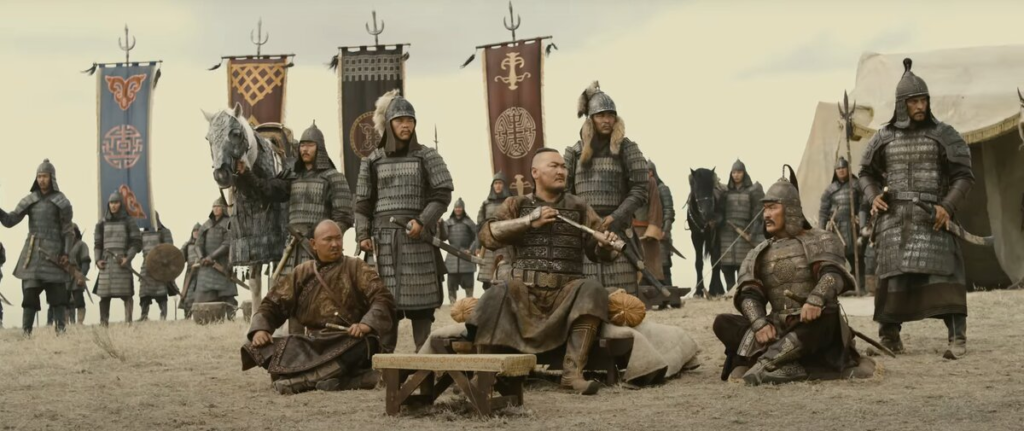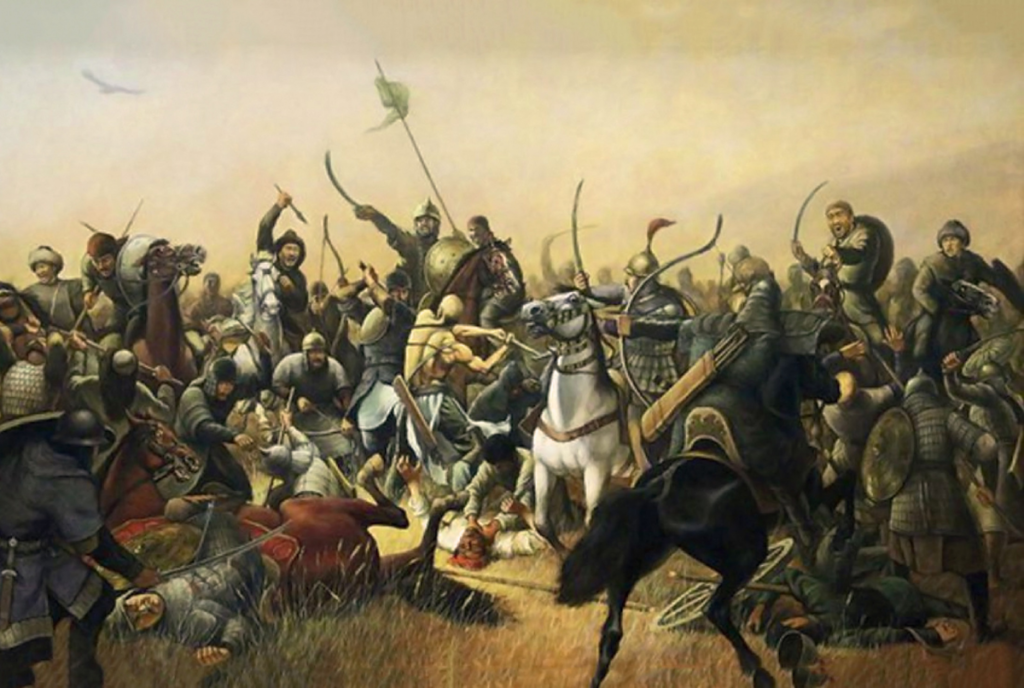By the 17th century, the sprawling Russian kingdom had already dealt with all the khanates around it. It was Moscow that became the main force in the region of Eastern Europe and entered into a complex confrontation with the Western countries and the Ottoman Empire — the main adversary in the unruly East.
At the same time, after Moscow’s victory over the Siberian Khanate and after the foundation of the fully controlled Kasimov Horde, led by the descendants of Kuchum Khan who swore oaths to the Tsar, the expansion of the Russian kingdom in Siberia continued. And naturally, sooner or later, there had to be a clash of Russian interests with the interests of another state — the Dzungarian Khanate, which owned vast lands in Southern Siberia and spread its influence up to Lake Baikal.
Today, continuing the series of articles about the states that once existed on the territory of the modern Russian Federation, we will talk about the so-called Dzungaria. In other words, about that mysterious country, which had almost no chance to stand in direct conflict with Moscow and the Qing Empire, which had gained strength. And yet the Khanate tried to resist and engaged in a long struggle for its existence.

Map from about 1709. The Dzungarian Empire, a «neighbor» of the Russian Empire, is highlighted in green. «Dzungarian Khanate — a state that once occupied part of modern Russia»: opponents of Russian expansion into Siberia
A fragment of the Mongol Empire
The Dzungar kingdom or, in some early sources, the «State of the Four Oirats», at the height of its power occupied part of the lands of modern Tajikistan, Kyrgyzstan, Kazakhstan, Mongolia and China, as well as the modern Altai and Krasnoyarsk Krai, the Republic of Tuva and part of the Irkutsk Oblast in the modern Russian Federation.
To this day, in these territories archaeologists come across Buddhist monasteries of the Oirats, which have survived only in the form of ruins — a faded reminder of the once-existing special culture that spread so widely.
The name is simultaneously associated with the Mongolian and Kalmyk language. And, with a conditional translation, it can be understood that the word «Dzungar» was used to name the left wing of the Mongolian army, which centuries ago was able to bring a huge number of countries and peoples to their knees. Because of their symbolic location on the map, the Dzungars compared themselves with the left edge of the once powerful Mongol Empire, whose territory they occupied for a century and a half.

Approximate borders of Dzungaria on the modern map. Realistically, the vassal power extended much further. «Dzungarian Khanate — a state that once occupied a part of modern Russia»: opponents of Russian expansion into Siberia
The birth of the state
At the very beginning of the 17th century, in territories that had long since lost statehood, representatives of several Oirat clans formed the Dzungarian Union, uniting under the most powerful Oirat Choros family. At the head of the new state stood Khara-Khula-taishi — a man of great intelligence and indomitable will, who was able to take the reins of power over wayward neighbors, long mired in feuds and intrigues. By the way, Hara-Khula-Taishi belonged to a really ancient family, which fought with the Northern Yuan — one of the Mongol dynasties back in 1399. And two ancestors of the new leader — Ugechi Hashigu and Mahamu even managed to establish the Oirat Khanate, which existed for a century and a half.
Immediately, the newly created state was tested for strength by various eastern neighbors. For example, as early as 1609, an 80,000-strong army led by Shola Ubashi, one of the Mongol rulers of that time, stormed the territory of Dzungaria. But the Dzungars were able to withstand the pressure and inflict a number of defeats. However, in 1615 the stubborn khan achieved his goal and won the general battle against the warriors of Khara-Khula.
In 1623 the war resumed with renewed vigor. But 36-thousand army under the leadership of Hara-Khula was defeated by superior Mongolian forces and up to 1627 the Dzungars were forced to conduct only guerrilla warfare. And they were very successful, because in that year, after a new battle, Sholoy Ubashi died during the battle, which predetermined the end of the Mongol expansion and the complete victory of Khara-Khula.
After the victory, a long time passed until the victorious Dzungars established their own khanate. And the period from 1635 to 1679 is considered the time of prosperity of the new state, which at this time rapidly expanded, added new territories and successfully fought with Russia and the Qing Empire.

The Dzungars in one of the modern film adaptations. «Dzungar Khanate — a state that once occupied part of modern Russia»: opponents of Russian expansion into Siberia
Period of prosperity
In 1640, during the general Mongol congress, the Dzungars established the main state religion of these places — Buddhism. And the new ruler of the Khanate — Batur-huntaiji, had such a great influence that his power and predominant role was recognized up to the North Caucasus and Northern Kazakhstan, as well as in Northern China and Tibet.
In 1657, the new ruler of Dzungaria — Khan Senge, began a struggle with the Khotogoyt Khanate, which ended in a decisive victory. But in 1671, as a result of an internal coup Senge was killed, and the throne was taken by his younger brother Galdan, who returned from Tibet to avenge his relative and get even with his offenders. Fortunately — he succeeded, as a result of which the new full-fledged ruler took the empty throne, preventing the state from plunging into civil war and disintegration. However, the «consolidation» of Galdan’s power continued until 1676, when the last oppositionists were defeated, expelled and killed.
The period of expansion of the Dzungars began, justified by the fact that the population of the city of Yarkend turned to Galdan for help, as the locals suffered a series of defeats from the Kara-Kirghiz, who invaded the territory of the small state formation, which ended with the loss of the capital. And Galdan came to the rescue, «under the noise» appropriating a number of territories.

Dzungarian Khan. «Dzungarian Khanate — a state that once occupied part of modern Russia»: opponents of Russian expansion into Siberia
«Years of great calamity» for Kazakhstan
The next opponent was the Kazakh Khanate, at the expense of which the Dzungarian Khanate wanted to add new territories. And a series of endless wars and battles between the two strong adversaries passes in the Kazakh chronicles as «Years of Great Disaster».
The history of conflicts between Kazakhs and Dzungars began in 1643, when the latter lost the Battle of Orbulak. But Galdan resumed hostilities and his troops in 1681 took a decisive revenge, and the troops of the Kazakh ruler — Tauke Khan, were defeated and scattered across the steppes.
In 1683, the Dzungarian military campaign gained momentum and turned out to be two more battles won. In general, at this stage, the khanate’s warriors reached the Syr Darya and Tashkent, destroying the Fergana Valley on the way and subjugating the Kirghiz.

One of the many battles of the era. «The Dzungarian Khanate was a state that once occupied part of modern Russia»: opponents of Russian expansion into Siberia
With Tsevan-Rabdan coming to power in Dzungaria, the already strong confrontation only increased, and the Kazakhs lost almost all their nomadic territories along the Irtysh and rolled further and further west.
In 1717, several more victories were recorded on the account of the Dzungarian Khanate, after which organized resistance from the Kazakh khans actually ceased. Because of this, by 1723 the Kazakh Khanate lost the territories of modern South Kazakhstan and Dzhambul regions, and the Kazakh statehood came to a critical point of its existence.
Only in 1729, after the loss of almost one third of its population, the united forces of Kazakhs were able to gain the upper hand in the Battle of Anrakai. But it helped little, as soon many local khans passed into the category of honorable captives-amanates (or sent as hostages their sons), finally recognizing vassal dependence on the ruler of Dzungaria.

The battle of the Dzungars with the Kazakhs. «The Dzungarian Khanate was a state that once occupied part of modern Russia»: opponents of Russian expansion into Siberia
War for Southern Siberia with Russia
It was the Dzungars who first attacked, in 1710 ruining the Bikatunsky stockaded town (now the town of Biysk in the Altai Territory). Already in 1716 3 thousand Russian detachment under the leadership of I.D. Bukhholts was blocked by 10 thousand army of Dzungars. Blocking took place in the freshly built Yamyshevskaya fortress (now — village Yamyshevo in Pavlodar region). And, it is necessary to tell, that the Russian colonel has suffered defeat as has lost 2,3 thousand people killed and died from hunger and diseases, after that has been compelled to roll back.
However, Buchholz did not intend to simply give up. And during the retreat, having lost a wagon with cannons and 200 thousand gold rubles, founded on the very outskirts of the Dzungarian Khanate, on the Irtysh River, a new major stronghold — the fortress of Omsk.
Soon, the troops of Colonel Stupin and Colonel Matigorov arrived on the border with the new irreconcilable enemy, which became a new page in the war for Southern Siberia, which continued with a long border conflict.
Good thing that the Dzungars were not up to the Russians — in 1715, a major war against the Qing Empire began at the other end of the empire. And up to 1737 both opposing sides seriously dried up each other’s forces until they came to the conclusion that no one would benefit, which ended with the establishment of peace in 1739.
The battles with the Qing Empire did not prevent the Dzungars from conducting several campaigns into Tibet. And it also resulted in a new protracted conflict, which lasted from 1716 to 1720, without revealing a clear winner.
The collapse of the Dzungarian Khanate
After Galdan-Tseren, a large country, which actually fought on equal terms on three fronts at once, began to «sink» in a new round of internal conflicts. At the moment when the prince (noyon) Amursan, suffering defeats from other pretenders to the Khan’s throne, called for help troops Qing, Dzungarian Khanate ceased to exist — the imperial simply took advantage of the favorable situation and «collapsed» their long-time adversaries.
Thanks to the efforts of 2 huge Manchu armies, almost 70% of the entire population of the dying Khanate was destroyed in an unprecedented massacre. And this, by the way, went down in history as the genocide of an individual people.
Only the prince (noyon) Sheareng was able to make a worthy resistance to the Manchus and was able to fight his way into the Kalmyk Khanate, coming to the banks of the Volga. Another part of the ulus went to Bukhara, Badakhshan and Afghanistan, becoming warriors in the service of local rulers and faithful followers of Islam.
Conclusion
Lev Gumilev wrote quite correctly about the historical role of the Dzungarian Khanate — it was this state that became the main obstacle on China’s path to the north and west, holding back untold hordes until 1758. And, in a sense, if it were not for the Dzungarian Khanate, there was a great probability that modern Siberia would belong to modern China rather than to the Russian Federation, which emerged victorious from a huge series of local conflicts.
